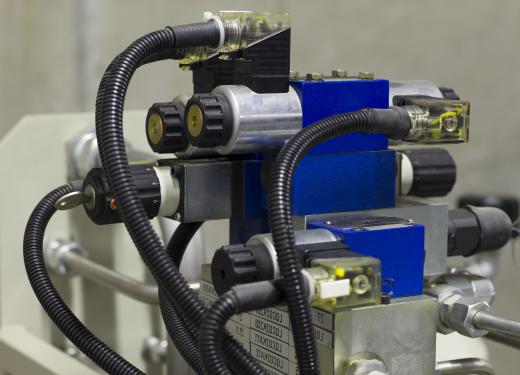A carbon dioxide (CO2) solenoid is an electromagnetic device that functions as a switch to control the stop and flow of carbon dioxide in an enclosed system. It is a small, but crucial component that is used with devices that release a controlled amount of carbon dioxide into places such as garden rooms, chambers or reservoirs. A CO2 solenoid is commonly composed of two parts: a solenoid and a solenoid valve.
The first solenoid was invented by a French physicist named Andre-Marie Ampere in the 19th century. Since then, the apparatus has become more sophisticated with its structure, precision and applications. There are many other types of solenoids that all have a general relationship with their function, such as open-frame solenoids, self-holding solenoids, tubular solenoids and various sizes of push-pull solenoids. A push-pull solenoid functions most similarly to the CO2 solenoid. This is preferable for CO2 solenoids because they can take up less space and still have enough force to control varying amounts of carbon dioxide release.

Within the CO2 solenoid, the solenoid's role is to convert electrical energy into mechanical energy, and the solenoid valve's role is to use that energy to release gas flow from one part of an enclosed system to the next. In horticulture, a certain amount of carbon dioxide is transferred from the CO2 tanks, through the regulator, through the CO2 solenoid and then into the garden area.
On one end, solenoids are connected to a timer or a carbon dioxide sensor that tells it when to release a certain amount of gas. The timer sends an electrical impulse to a spring inside the solenoid that controls gas flow to the solenoid valve. The impulse functions as a command to create an opening between the regulator and the solenoid, which is at the other end. This allows a specified amount of CO2 to be released from the system. The exact amount of gas that is released is controlled by the regulator to which the CO2 solenoid is connected.
CO2 solenoids are most frequently used in applications that involve photosynthesis. In applications that do not involve photosynthesis and require a constant level of carbon dioxide, a CO2 solenoid isn't necessary because a regulator alone will control the CO2 levels. CO2 solenoids are needed in plant applications because plants use varying amounts of carbon dioxide throughout the day. Therefore, a CO2 solenoid that has a sensor built into it will know how much CO2 an aquarium or greenhouse needs based on plant consumption. This function also prevents carbon dioxide waste within a contained area.
